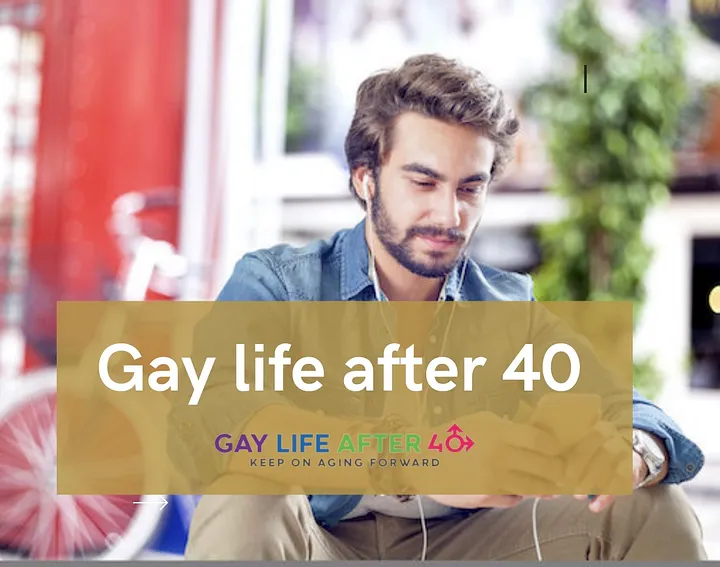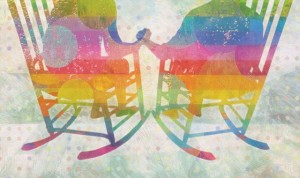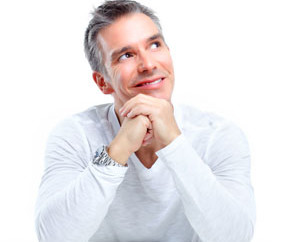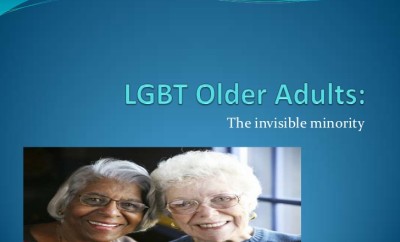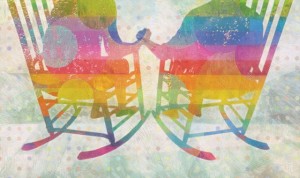
When I’m Old and Gay
When I’m Old and Gay
Retirement can be sweet for well-off LGBT elders, but it is fraught with perils for most.
When Marcia Hickman and Sue Spirit first started talking retirement 20 years ago, they mostly worried about the location and the weather. In Ohio, where they met and ran a women’s retreat together, Marcia missed the mountains of her upstate New York youth. Sue wanted a place “with seasons.” The pair, who will celebrate 30 years together in August, describe themselves as “mostly out”—Marcia hasn’t told her three children she and Sue are a couple, but she figures they’ve put it together by now. She and Sue hadn’t thought about settling down with other gay people until they learned about Carefree Cove. “Around 2000 we heard about ‘lesbian land’ being started in North Carolina,” Sue says. A planned residential community for older gay men, lesbians, and transgendered people, “the Cove” was then an empty 165-acre plot 20 miles outside of Boone, a small university town in the Blue Ridge Mountains. The backers had an opening bargain: For $2,000, you could come down and pick your lot. “We put down the money, and six months later we were building,” Sue says.
In the 1960s and 1970s, members of the Stonewall generation carved out communities like the Castro in San Francisco, the West Village in New York, and Dupont Circle in Washington, D.C., safe havens where a man could walk down the street in heels without causing a ruckus or a lesbian couple could hold hands while shopping. The gay retirement villas sprouting up at the turn of the millennium were far more commercial—and planned—than those early “gayborhoods,” but at a basic level what they offered was similar: insulation from prejudice, places where queer people were free to be queer. But as the wrought-iron gate at its entrance suggests, the Cove is far more exclusive than an urban neighborhood.
Set against a densely wooded incline with winding dirt roads, the Cove could have been plucked from a travel brochure for the Bavarian Alps. From a cleared plot at the apex of the development—the site of a planned clubhouse—stone chimneys poke through a canopy of trees. Along the horizon, the mountain ranges crowd against each other, gradient shades of purple fighting for the skyline. It’s summer, before the humidity has set in, and the air is crisp and clean.
Cathy Groene, one of the Cove’s developers, gives me a tour of the grounds. As she descends along the main dirt road, she stops periodically to point out one of the project’s 25 homes—all log, stone, or cedar-sided cabins, as required by the charter. She offers a detail about each occupant as we go; everybody knows everybody here. Along the path, beech and maple trees soar into the sky, and sunlight filters through the leaves. Daniel Boone, who opened up the Appalachians, is purported to have said he had “never been lost but was bewildered once for about three days.” This is the sort of place where you wouldn’t mind being bewildered for a while.
The Cove sprouted up along with a handful of bucolic retreats for LGBT elders in the early 2000s. With the baby-boomer generation on the cusp of retirement and the economy chugging along at full speed, gay and lesbian entrepreneurs saw an opportunity to create retreats for people like themselves and cash in on the emerging market of 1.5 million gay elderly (and growing). When it opened in 1997, the beachside Palms of Manasota outside Tampa, Florida, billed itself as the first all-LGBT retirement community; unlike the couple of developments that opened up for women in the mid-1990s, the Palms was co-ed. The Cove’s opening in 2001 was followed by the environmentally conscious Birds of a Feather in Pecos, New Mexico, in 2004; the upscale, adobe-dotted Rainbow Vision in nearby Santa Fe in 2006; and Rainbow Vista in Gresham, Oregon, in 2007. As with other luxury retirement developments, the recession dealt a blow to this burgeoning market; the Palms and Rainbow Vision declared bankruptcy while other projects were put on hold. But this summer, with the economy picking up again, the ritzy Fountaingrove Lodge—it has an orchard, wine cellar, golf course, and entrance fees as high as $900,000—is set to open in Santa Rosa, California.
Earlier models of all-gay communities were considerably more austere and typically women-only. Since the 1970s, radical “land dykes” (as in “back to the land”) have operated separatist colonies in rural outposts. While planned, these backwoods communes—some without electricity or running water—share little in common with the comfortable lifestyle at the Cove. The closest analogue, and immediate predecessor, to LGBT senior retreats are the handful of women’s RV communities that sprung up in the mid-1990s in Arizona, Florida, and Oregon. One of them—the Pueblo in Apache Junction, Arizona—caters to retirees.
The Pueblo was one of the places Groene and her partner of 24 years, Gina Razete, scouted when they started looking for a place to retire. While the couple are avid RVers, they did not want to spend the rest of their lives beating back the desert sun. Groene and Razete, who has a background in real-estate development, decided to create from the ground up the sort of women’s community they’d want to live in. In 1994, they opened the Resort on Carefree Boulevard in Fort Myers, Florida—278 RVs and manufactured homes on 50 acres dotted with ponds. The lots went quickly, and by 1996 more than 300 older lesbians called the Resort home.
Spurred by the Resort’s success, Groene and Razete sought to create a similar haven in the mountains of North Carolina. Like its predecessor, the Cove was originally restricted to women. But to broaden the target market, the developers opened up the project to men. Razete and Groene estimate the ratio of women to men at the Cove at 60–40. While a handful of gay men want nothing to do with the other residents—“the boys at the top of the hill,” they’re called—down the hollow there is a strong sense of community. One of the residents hosts a potluck each month. Members tend a communal garden right inside the Cove’s entrance. In town, the High Country Lesbians hold game nights and movie outings, while Appalachian State University runs a continuing-education program for the elderly.
“It’s nice to know that if you want to go down the road holding hands, nobody is going to shoot you.”But more than picturesque scenery and an active social life, the Cove guarantees security. Lissa Brown, a writer and former teacher who just turned 70, puts it wryly: “It’s nice when you live in an area like this to know that if you want to go down the road holding hands, you can do it. Nobody is going to shoot you.” For Brown’s generation of gay people, that sense of security is still a precious—and fragile—thing. Thirty years from now, given the dramatic rise in public support for gay rights, queer retirees will be able to take for granted that they will be accepted and understood in any retirement setting. For Stonewallers, however, peace of mind is an essential appeal of living in a community like Carefree Cove. But it comes with a hefty price tag—one that few LGBT seniors can afford.
Despite the stereotype of the affluent gay, more LGBT seniors live in poverty than their straight counterparts. Half reach retirement with only $10,000 in the bank. They are far less likely than younger gays to be partnered or married. They’re more likely to be childless and estranged from their birth families, leaving them to weather the challenges of retirement alone. Even those with long-term partners are at a disadvantage, despite recent legal breakthroughs. In June, the Supreme Court struck down the Defense of Marriage Act, putting some gay couples on equal legal footing with straight couples for the first time, but that’s little help to older gay couples who have missed out on decades’ worth of tax and insurance breaks.
 All those factors leave queer seniors with fewer retirement options than their straight counterparts. Without the social support or financial means to ensure independence, they often become separated from their gay communities and “families of choice.” Whether they rely on home-care workers or move into assisted-living facilities paid for by Medicaid, they often encounter staff and residents who are not comfortable with gay people. Fearful of mistreatment, many feel compelled to go back into the closet-—particularly painful for members of the generation that invented the politics of coming out. For those who aren’t lucky enough to settle down in a place like Carefree Cove, the golden years can still look a lot like the pre-Stonewall years.
All those factors leave queer seniors with fewer retirement options than their straight counterparts. Without the social support or financial means to ensure independence, they often become separated from their gay communities and “families of choice.” Whether they rely on home-care workers or move into assisted-living facilities paid for by Medicaid, they often encounter staff and residents who are not comfortable with gay people. Fearful of mistreatment, many feel compelled to go back into the closet-—particularly painful for members of the generation that invented the politics of coming out. For those who aren’t lucky enough to settle down in a place like Carefree Cove, the golden years can still look a lot like the pre-Stonewall years.
A self-described “dyke” in her sixties, Imani Woody has worked with LGBT seniors and their caregivers for the past 20 years. As Washington, D.C.’s local outreach director for SAGE (Services and Advocacy for GLBT Elders), the country’s largest advocacy organization for older gay folk, Woody conducts sensitivity training for nursing-home staff and connects low-income elderly with public housing and HIV/AIDS services. She’s met countless LGBT seniors who’ve ended up “re-closeting” themselves.
Sarah (not her real name) came out in the 1980s at the height of the AIDS crisis. A member of the Nubian Women, a social group for African American women over 35, she was, in Woody’s words, “a big dyke girl back in the day.” In suits, creased pants, and tailored shirts, girlfriend du jour in tow, she was a fixture at LGBT social events and rallies. “She was political,” Woody says. “She was in the mix.” All that changed when Sarah, who had been married with children before coming out, hit old age. Doctor visits replaced social invitations. As health problems kicked in, Sarah drifted from the gay community and came to rely on her children for support. She still preferred jeans to dresses, but by the time she met Woody, she no longer identified as a lesbian. “She told me, ‘All that gay stuff, I don’t do that anymore,’” Woody says. “All that gay stuff, I don’t do that anymore.”Afraid of raising eyebrows at her grandchildren’s school, Sarah makes sure to “dress fem” before picking them up. “Her world was big,” Woody says, “and now it has shrunk.”
Few eldercare institutions have LGBT-inclusive policies, and care-givers often don’t know how to look after queer folk. “Although a lot of folks in this area are competent at taking care of adults, LGBT people are nowhere on their radar screen,” says Lisa Krinsky, director of the LGBT Aging Project, which advocates for the rights of queer seniors. According to a 2011 report from the National Academy on an Aging Society, less than one-third of eldercare agencies offer gay-sensitivity training. Most nursing homes do not ask on their intake forms if a person has a same-sex partner. Without gestures to signal that it’s safe to be gay, many elderly—who have lived much, if not most, of their lives in the closet—assume that it is not. “I worked in five nursing homes over 27 years, and I only encountered one man—only one—who was openly gay,” says Mary Blanchett, a licensed nursing-home administrator who formerly ran a group that helps gay seniors plan for retirement. “That tells you something.”
Worse, active discrimination drives some back into the closet. “The disaster scenario is encountering a staff that is homophobic, that is transphobic,” says Robert Espinoza, senior director for public policy and communications at SAGE. “You go from a life that is independent and with friends and open and proud and enter a space where you have to re-enter the closet.”
 Accurate data about older gay people’s lives are hard to come by, partly because while federal law requires eldercare institutions to report statistics on other groups of minority residents, that’s not the case with queer folk. But a 2011 study conducted by six LGBT advocacy groups provides a snapshot of what life looks like in old age. In long-term care facilities, 43 percent of residents, relatives, and staff members reported that they had witnessed or experienced harassment based on perceived sexual orientation. Advocates for the elderly say that accords with the anecdotal reports they hear. Elderly residents sometimes speak in disapproving whispers about the one gay person on the floor; they may use anti-gay slurs or single gays out for social exclusion. Staff members at nursing homes may refuse to care for queer residents or use gloves when they typically would not. Pictures of same-sex partners are taken down. Conservative Christian residents and staffers, concerned for gay people’s mortal souls, openly pray for them to leave the “homosexual lifestyle” or actively try to convert them.
Accurate data about older gay people’s lives are hard to come by, partly because while federal law requires eldercare institutions to report statistics on other groups of minority residents, that’s not the case with queer folk. But a 2011 study conducted by six LGBT advocacy groups provides a snapshot of what life looks like in old age. In long-term care facilities, 43 percent of residents, relatives, and staff members reported that they had witnessed or experienced harassment based on perceived sexual orientation. Advocates for the elderly say that accords with the anecdotal reports they hear. Elderly residents sometimes speak in disapproving whispers about the one gay person on the floor; they may use anti-gay slurs or single gays out for social exclusion. Staff members at nursing homes may refuse to care for queer residents or use gloves when they typically would not. Pictures of same-sex partners are taken down. Conservative Christian residents and staffers, concerned for gay people’s mortal souls, openly pray for them to leave the “homosexual lifestyle” or actively try to convert them.
Even in their own homes, LGBT seniors often fear mistreatment at the hands of home health-care workers if they’re open about themselves. Group members talk about the need to “de-gay” the house.Ken South of Prime Timers D.C., a social club for older gay and bisexual men, says group members joke about the need to “de-gay” the house—queer periodicals like The Advocate go at the bottom of the stack, pictures of a same-sex partner are moved to an isolated room. They even worry about being found out after they die, South says. “I’ve heard friends say, half -kidding, ‘I have to put this in my will: The executor of my estate has to clean out my computer, get rid of all the magazines and pictures.’”
On a Wednesday evening in June, members of Prime Timers trickle into the upstairs bar of Dupont Italian Kitchen on Washington’s 17th Street. The strip is home to some of the city’s oldest gay bars, but Ken South says it wasn’t easy to find one that would host a weekly meeting of older gay guys. “I could stand naked in the corner at one of those places and be totally ignored,” says South, who is 67 and works at an HIV–advocacy organization. The staff here is friendly, though; the lone server upstairs, who looks to be in his twenties, weaves through the crowd of about two dozen, distributing drinks. “Here you go, honey,” he says, placing his hand on one of the group’s older members, a man in his eighties. The conversation keeps drifting back to aging. “Someone called me ‘sir’ on the Metro coming in,” says one man in his fifties. “The only place I want to be called ‘sir’ is in the bedroom,” South replies. Ageism is prevalent among gay men—the joke is that you’re dead at 30—and it fuels the loneliness that often accompanies old age.
Prime Timers, like other social groups for older gays, is designed to be an antidote to that loneliness. It’s also part of a larger “aging in place” movement, an effort to help the elderly stay in their communities, live at home as long as possible, and maintain contact with people of different ages. While a few Prime Timers have moved into assisted-living facilities in the District, most continue to live in the homes and neighborhoods they’ve inhabited for years. Some are not out in broader society, but the group’s weekly meetings provide a point of contact with the gay community, a place to make friends, find lovers, and commiserate.
The trend toward aging in place is reflected in an increasing demand for retirement options in the urban centers that are the heart of gay culture. “Some retirement communities are being created out in suburbs, but it’s not a big draw for LGBT seniors I work with,” says Seth Kilbourn, executive director of Openhouse, a San Francisco–based advocacy organization for LGBT seniors. “They don’t necessarily want that golf-course kind of experience. They want to continue to go to the opera.” Fortunately, the largest new retirement centers in cities cater to those who can’t afford a Carefree Cove or a Fountaingrove Lodge—or don’t have their own homes to stay in, like many of the Prime Timers. Openhouse is renovating a residential hall and breaking ground on an adjacent complex in downtown San Francisco for low-income LGBT seniors. It follows Triangle Square in Los Angeles, which opened in 2007 and similarly serves low-income people. Philadelphia’s William Way Senior Residences are set to open later this year. While all of these developments are for low-income people, Kilbourn says Openhouse hopes to break ground on middle-class complexes in the future.
Even with these new developments, however, few gay retirees will have the option of living in an all-gay environment. So advocates like Imani Woody are working to make traditional housing options friendlier by educating staff and residents at retirement centers. It’s basic stuff. “It’s as simple as learning what a transgendered person is,” Woody says. “You want to look for signs that there might be a gay couple—a patient may call them their ‘significant other’ or use the group pronoun ‘they.’”
In another generation or two, society will have provided all the sensitivity training the retirement industry needs. Tomorrow’s home- and health-care workers will have grown up in a culture that doesn’t tolerate prejudice against LGBT people, and so will have straight retirees. For members of the Stonewall generation, it’s a bittersweet irony: While old age is fraught with difficulties, they have laid the groundwork for retirement to ultimately be just as gay-friendly as the streets of Chelsea.
_____________________________________________________________________________________________________
August 22, 2013
About the Author
____________________________________________________________________________________________________-
